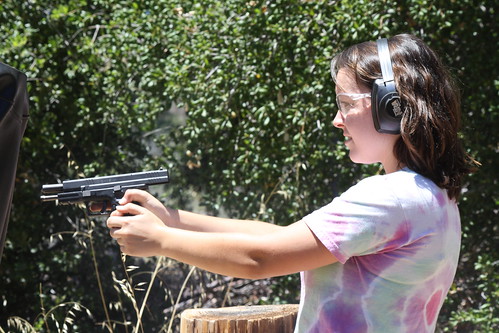With this in mind, you have to be prepared to make your move while possibly using one hand to keep an attacker at bay or even having been wounded and only being able to defend yourself with your remaining hand.
Whether wounded or defending yourself from blows you should be comfortable and confident in operating your firearm single handedly.
Single Hand Shooting
Depending on where you took your concealed carry class, you most likely had to shoot without a support hand. But a concealed carry class shouldn’t be the only time you practice shooting single handedly.
While shooting with one hand may not seem like a big deal, you’re now shooting without a support hand which affects your grip and ability to control recoil. Whenever you’re out at the range, make sure you’re practicing.
Support Hand Shooting
In a defensive situation, if your main hand is incapacitated, your only other option for defending yourself will be your offhand. For this reason, you’ll obviously want to make sure you’re proficient at shooting with your other hand.
While the same difficulties exist as shooting with only your main hand, they are now amplified. Off hands tend to be weaker and also experience more recoil. It’s akin to trying to operate the pedals of your manual car with the opposite feet. With your legs crossed aside, your feet have adjusted to how to press the pedals and your right foot on the clutch will certainly not be as gentle as your left has learned to be.
Your trigger control and grip on your off hand are possibly nonexistent. Beginning with dry-fire practice at home, train your offhand to be as proficient as possible. You may not reach the same level of comfort or proficiency with your offhand as your main hand, especially overnight, but you don’t have to be perfect.
If your pistol doesn’t have ambidextrous controls, you should also practice operating the magazine release and safety with your offhand. Sometimes this mean using your index finger instead of your thumb to press a magazine release or bringing your thumb over to disengage a safety.
Single Hand Reloads
Reloading under pressure can be difficult enough. Take away the use of one of your hands and it certainly gets more complicated.
If you’re using a pistol, the slide will lock back after the last round in your magazine has been fired. From here drop the mag. If your holster is readily available and maintains shape (made of kydex or a similar material) you can use it to hold the gun while you slam another magazine in. From here you can either use the slide release or your rear sight or RMR by catching it on a hard surface or your belt to push the slide back and release it that way.
Another method involved simply tucking your gun under the arm you’re not using (after dropping the magazine) and then using it to hold the firearm while loading in another magazine. You can also use your pants to hold the pistol as well.
With revolvers the process can literally be a bit more of a pain. While opening the cylinder using your thumb to disengage it and index finger to push the cylinder out, you’re left with two options to push the ejector rod and clear spent shells.
While it is possible to adjust your grip and use a finger to push down on the rod while simultaneously this fine motor function takes practice and has a higher chance of failing during a high stress scenario.
One other option is to use your chin to push down on the rod and clear the cylinder. Of course, this is assuming your off hand is completely useless. If not, you could use it or your forearm to press the rod.
After emptying the cylinder, tuck the revolver either under your arm or into your holster partially or your pants and reload the cylinder. Obviously having a speed loader for your revolver is extremely helpful here, although it’s not impossible to load the cylinder manually.
Once loaded press the cylinder closed using your body and you’re ready to go.
Handling Malfunctions With One Hand
Being able to clear a malfunction is another thing that can be extremely stressful under duress. Indeed, it might seem impossible to do with one hand. However, if you’ve gotten comfortable with reloading singlehandedly, this is something you’ll be prepared for.
The methods employed here are similar to reloading single handed except in a different order. After dropping the magazine you’ll have to rack the slide to clear the chamber. Again, utilizing your belt to catch your rear sight or RMR pull your slide all the way back. If possible, you’ll also want to lock the slide to make it easier to reload, although this can be harder without an ambidextrous slide stop when done with your off hand.
Off-hand Draw
When choosing how to carry your pistol always take into consideration you may have to draw with your non-dominant hand. For this reason, carrying at the 3 o’clock position, right side of the hip or in the pocket, is the least recommended. This position is the hardest to draw from for right-handed shooters with the opposite obviously being the most difficult for left handed individuals.
Carrying almost anywhere on the back or front makes it much easier to access your firearm with your non-dominant hand should your dominant hand be unable to.
Final Thoughts
Firearms require two hands to operate and maximum efficiency but that doesn’t mean just because you lose the use of a hand or arm that you’ll be completely defenseless. While practicing these techniques, it’s common to press your “incapacitated” arm tightly against your body since realistically it wouldn’t be use due to be damaged and by applying pressure with your body you can help slow bleeding of a possible wound.
Also, while practicing you may want to use an old belt or one you don’t care about as the sights can damage it. I’ve seen it recommended to use hard surfaces like countertops to catch your rear sight as well and while it doesn’t hurt to practice, keep in mind you may not always have the edge of a surface at your disposal, but your carry belt will be there. Good luck!


